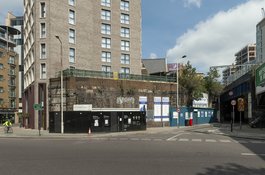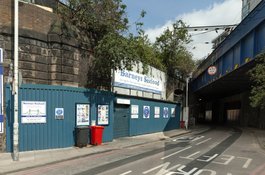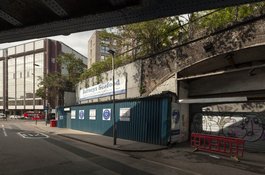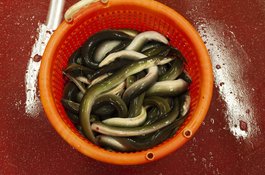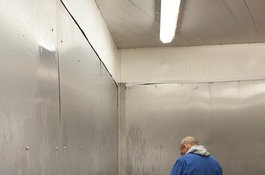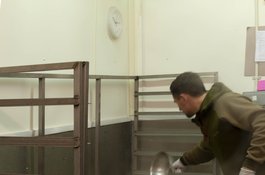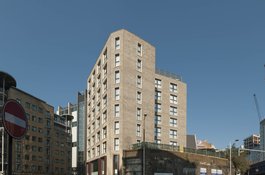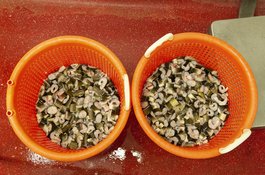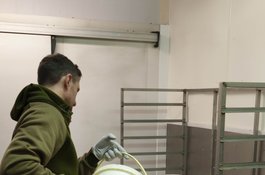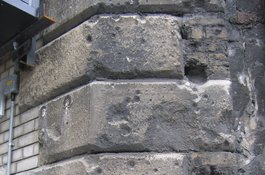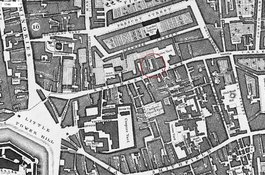Mark Button on jellied eels, Barneys Seafood and changes around Chamber Street
Contributed by Survey of London on Nov. 8, 2020
Mark Button, managing director of Barneys Seafood, talked about the business on the shortly before its move from 55 Chamber Street in October 2019 to New Billingsgate at Canary Wharf, pending redevelopment of this site:
'I was born in the East London maternity hospital in 1965… Our family was very much from the East London. … my father used to work as a young lad helping his father with his {building} trade, doing small jobs. At a very young age, 12 or 14, he decided he didn’t want to do that so he started to look around for other work. He was one of 14 children... He worked for many people in Stratford, he worked for Cooke’s pie shop in Stratford, and various other places, he then got a job at the old Billingsgate Market working with eels, being a blocksman with fish, where they would prep fish for West End restaurants.. and he bought a seafood stall in the 1960s which was at Aldgate, which was known as Barney’s, which was the famous relative of [Solomon Gritzman, who had taken over the] Tubby Isaacs [name]. Barney and Tubby were two brothers [Barney and Solomon Gritzman] and we ended up taking over the Barney's business in 1968/69 I believe, and from there we developed the wholesalers and into the early Seventies even when Tubby Isaacs decided he didn’t want to do his own jellied eels any more and asked my father, Eddie Button, to do his eels as well, with the understanding that no one knew, as there was a feud between the two brothers: no one could know it was the same supplier supplying both sides of the road… they’d even spit at each other…. From the 1970s to early 2000s we supplied the stalls at Aldgate and sadly there’s no more traditional jellied eel seafood outlets in the East End, as we know.
'[This] shop at 55 Chamber Street was originally the lockup for the stalls at Aldgate, for the Barneys stall and we’ve recently found some plans for drainage from 1938 [that] showed on the map eel tanks…
'It was about the late Seventies early Eighties …[when] we closed the Barneys stall down as there wasn’t enough trade for two stalls ….up to about five or six years ago [we still had one stall] …. but sadly with the red routes, no parking, double lines, no taxi drivers allowed to stop, changing it all back to a two-way system from one way, the Congestion Charge, all the things which put people off of coming in to certain areas so it slowly killed the trade.
'How did jellied eels start? Many, many years ago eels were fairly cheap, the Thames was full of them, … there was oyster pies, eel pies, … [then it] moved from a way of preserving them to cook them and set them in jelly, I mean an eel sets in its natural jelly if you was just to cook it and let it go cold it does create a jelly but obviously on a commercial basis we have to add gelatine now to give it shelf life… We do send eels all around the UK, to people who’ve moved away from London. We post … a lot on the South coast, Kent coast is still a very good area for jellied eels and even down to Devon and Cornwall.
'[As for making jellied eels now...] the eels arrive in to us daily, live quality, meaning they get flown over this time of the year, in the summer, from Lough Neagh [near Belfast]… then the eels are cleaned, then they’re gutted, as one process, then they’re cut in to mouth-size pieces, then it’s all washed and then the raw material is cooked in boiling water, we add some salt and some spices just to take off any earthiness the wild eels might have, and because of the volumes we’re cooking we have to use a gelatine based product to set the eels in. It’s a boiling liquid that then gets put in to a fridge overnight and the following day they are set as jellied eels.
'[Jellied eels is] still the main part of what we do, as Barneys... it's what we’ve always done... From when I first came here we did 90 per cent jellied eels and 10 per cent other shellfish… now we possibly do 40 per cent jellied eels and 60 per cent other shellfish, but the 40 per cent is still a large per centage of the eels industry for the south of England. We’ve got some very big customers at places like Leigh on Sea and Southend, which are still traditional London venues, for when the sun’s out. We supply wholesalers in Lowestoft, wholesalers down in Folkestone, on the Kent coast, and as I say we send stuff all over the place.
'[Retail has grown in this shop at 55 Chamber Street]. When I first came here, we’d walk in in the morning and we’d have six or seven staff here, then, and we used to close the door behind us, because there was so much work going on in the factory, my father didn’t encourage anyone off the street to come in, because we was mainly jellied eel manufacturers, we’d cook crab, we’d cook lobster, we’d boil winkles, we’d cook whelks, and we were so busy no one had time to go and serve anybody.
'It’s only possibly been in the last 10 12 years since my father hasn’t been around that we can’t sit there looking at each other when you’re not doing as much work, so you open the doors, you put some freezer display cabinets in, people can come in and see what you do, and we still have people walking in now and saying “I didn’t know you were here and I only live round the corner,”… last seven years, eight years, but most people go past when we’re closed… because we open the doors about 4.30 am and we’re here most days till about 1.30 in the afternoon which is roughly when we’re winding down and finishing work. But we’ve had to develop with the times go with the people around you, if we just sat there and closed the doors… it’s about 30 per cent of the business I think now, people that walk in off the street. And with things like credit cards they can just come in and buy stuff and take it home, we supply cool bags and cool blocks and we’ve got a good little following, whether it’s people visiting for the day, students staying here, people sailing their boats into St Katherine’s Dock… we get everyone coming here. And you don’t know who they are till you start talking and …y’know they’ve been sailing for six months and they come back here every year or so, and they come and find us again. And it’s retired people from America, all walks of life, you know, whether they’re scraping together a few pennies to buy something or they’re multimillionaires who just love a bit of jellied eels and seafood.
'[S]adly we’re having to move from this area in the next few months, so we’re going to be heading towards the [New] Billingsgate area, back out towards Barking, where the new fish market is proposed to be... 36 years ago [Billingsgate Market] moved from Lower Thames Street, on the river, to Canary Wharf, which was the great move of the time, and it moved from a cobbled street to a place with readymade car parks and readymade cold stores, and it was hi tech at the time. It’s not hi tech today, when you look at other European markets, but once again the land values of Canary Wharf have outstripped the usage of a fish market which only trades from 3am until 9am even though there’s ancillary people there working and office people there working but the land value is deemed to be... too great an asset to the Corporation of London, who own the site, and the London markets, whether it’s the Smithfield meat aarket, the Billingsgate fish market, [Spitalfields,] the fruit and veg which is at Leyton, the plans are to amalgamate all three markets at the site in Barking as we’re speaking now there’s consultation papers out, it’s not been published, passed by Parliament yet, but, allegedly that could happen at any moment.
'... well the we’ve been surrounded by development over the last six or seven years, very close to us, and developers have been building on the back of our railway arch, and when Network Rail, our landlord with 50-plus years of us being tenants, paying our rents, on time, never missed, sold the site on to, I believe, it was an American finance company for several billions of pounds... we were in negotiation with our rent and the next thing we know, six months later we got a letter saying our new landlord is the developer behind us... We didn’t know anything about it, no explanation, you just get a letter saying we’re no longer your landlord, but the developer who is behind you is, so the first we did was spoke to them and they said “Well, we are developers and you’ve got about nine months here, from now”.
'That was back in January 2019, so... my plan, y’know... I could have panicked, shut up the shop and said “That’s it, had enough, going to do something else.” But because I came here at the age of 18 and apart from the 3am alarm going off most mornings - it used to be seven mornings a week, it’s now only six - I’m fortunate my son’s now in the business, he’s 21, so maybe I only come down five mornings a week, and he covers the time I’m not here. I decided, and he wants to carry on doing it, he enjoys it, in some sad way as we all do, once it’s in the blood I think it’s there. He remembers his grandad talking about it as much as I do and... we’ve enjoyed the trappings from the hard work, and... we’re looking at a few options at the moment, even moving back to Billingsgate for the last four to five years of their time there, at Canary Wharf, and then with the prospect of moving to Barking, with the new market, and seeing what that brings with a multicultural type market that bring.
'It’s been changing in many ways over the past few years, but there’s till a call for traditional shellfish, which is what we do. The jellied eel side of the business is declining but with trends changing and different types of people moving back in to the area, people are willing to try these things again. What becomes a fad can go out of fashion, but it can also come back in to fashion, and even if it’s a bigger market, trying a smaller quantity of, for example, jellied eels, we’ve got more people to try them and it could still keep the sales at a reasonable level... Sadly old East Enders aren’t lasting as long as … y’know all the generations we’ve served have sadly moving on to different places.
'[As for this site...] the particular company who’s developed behind us they’re into apartment hotels, so they’re large hotel rooms with kitchens and lounge-type areas which they rent out on a daily or weekly basis, trying to get a lot of business customers involved, so they have people there, staff or people travelling in from outside of London so you can rent an apartment which has its own kitchen facilities as cheap as a hotel room in London , which is quite nice if you want the freedom, you don’t want to go out for a meal when you could just cook yourself something in a room, they’ve built 57 (!) apartment hotels behind us over the last three years and the site we’re on they’re planning to do the same thing.
'...the lockup we’ve got next door, which is 56 Chamber Street, because it’s a live rail structure, they couldn’t buy the freehold to this but allegedly they’ve got it on a 200-year lease, and they can’t change the structure of the arch but as I say as there’s a live feed on it which goes across the main Fenchurch Street line. But it’s got a yard area [where] they can build ... going up higher than the railway and I’ve seen plans of a nice glass cubed building... That’ll be office space I’m sure. And allegedly the Chinese embassy is moving round the corner to Royal Mint Street, where the old royal mint [is], and that will bring more and more people in to the area, which is already a busy area, most of the time... At weekends we've got more Europeans moving in, Leman Street has got a lot of Chinese and Asian students coming in from the Far East. It creates a different dynamic in the area, there’s the bars and restaurants, there are City people during the week and a lot of students at weekends, but they also like fresh fish and live produce, so we’ve got busier on our local trade over the last two to three years. ...Sadly we’ll be moving away and I’m sure there is scope to do something in this area for more of a retail or a consumable type seafood place, but that’s another plan we’ve got to look forward to.
'We have to officially move out of here at the end of September [2019], which is quite soon now as we’re almost at the end of June, and we still haven’t got an official address to go to, though there are a few things in the pipeline, but by the end of September we’ll be out of here, another chapter in the Barney lifestyle moving on...'
Barneys opened their new outlet in New Billingsgate Market in October 2019.
Mark Button was talking to Aileen Reid of the Survey of London, 26 June 2019.
Saving the Blitz Damaged Wall
Contributed by danny on May 6, 2020
I remember as a young kid, being shown by my dad, that the damage visible on the supports to the railway bridge that diagonally crossed the junction of Mansell Street, with Goodman's Yard at the end of Prescot Street was from World War II. While the bridge itself, which led to Haydon Yard Good's Depot was demolished in the 70s, the bridge support and parts of the spur off the London & Tilbury line into Fenchurch Street remained. I went to Tower Hill Primary School which was situated in Chamber Street and the spur was still used for goods traffic until the mid 60s so we would occasionally see, and more often hear, wagons and locomotives moving along past the school building.
I repeated the story of the bomb damage to my own children, to nieces and nephews and to visitors when we passed this site over the years.
In late 2019, I saw notices suggesting that the developer of the site, Marldon was intending to demolish the spur with the inevitable loss of this remaining evidence of the horrors wrought on the East End of London by Hitler's Blitz starting in 1940. Few examples of that damage remain. I decided we could not lose this important piece of history and I was going to do my best to ensure it remained. Earlier in the year, there had been a posting on the East End Preservation Society Twitter feed noting the damage to the wall and recognising its importance.
I posted that it was now under threat and that received a largely supportive set of comments that it should be saved. I spoke to the developer too, as I had had some previous friendly discussions with them about other matters. The solution they proposed was to resite some of the damaged stonework in a courtyard within the development that would not be either accessible all the time nor obvious to those unaware of the wall. I did not think that was a satisfactory solution so I was advised to try and get the wall listed by Historic England.
I submitted an application, but in due course, they refused on the grounds that although the wall was an imporant relic of the war, it failed to qualify for listing as "there was no story!".
For me, the story was that which had been told to me by my dad, and the story I had told of the wall to my family. Despite this, my raising of the matter, and a post that Historic England had turned down a listing seemed to come to the attention of Tower Hamlets Council and TfL. The former had approved the original proposal to demolish but now had been chastened by local opinion. Both the council and TfL seemed to caution that the developer should be sensitive to the importance of the wall - perhaps to its "story".
What has happened since then, is that the developer has now re-worked the proposal so that the wall and damaged brickwork is incorporated into the new development, and the wall will have its story told in an accompanying glass panel.
From what I can see, this will add interest to the development on this quite iconic corner. It will preserve the wall and its record of the dreadfulness of war, and other mums and dads will be able to show their children the story and encourage them to build a world where some catastrophic wars never occur again.
Danny McLaughlin - May 2020
